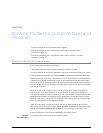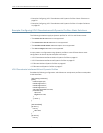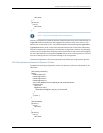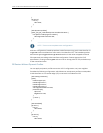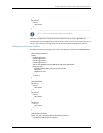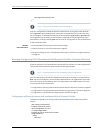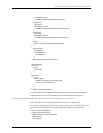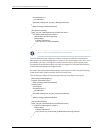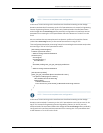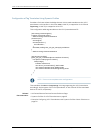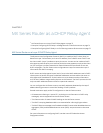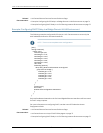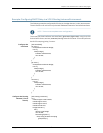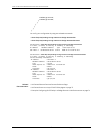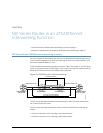
site sample-site-1 {
site-identifier 1;
}
associate-profile green_vpls_pw_1; # Apply profile here
}
... # Other routing instance statements
[edit dynamic-profiles]
green_vpls_pw_1 interfaces $junos-interface-ifd-name {
unit $junos-underlying-unit-number {
vlan-id 200; # This is the outer tag
family bridge {
interface-mode trunk;
inner-vlan-id-list [ 10 20 30 40 50 ];
}
}
}
NOTE: This is not a complete router configuration.
With the dynamic profile, a packet in a frame arriving on an interface is classified as
belonging to one of the bridge domains (VLANs 10–50). At the egress of the trunk VPLS
pseudowire, the outer VLAN tag 200 is pushed onto the frame. At the ingress of the
psuedowire at the remote location, the outer VLAN tag 200 is removed and the frame
is delivered to the appropriate bridge domain.
But what if the packets associated with the Accounting VLAN are not to be forwarding
to the remote site? Dynamic profiles are useful here as well.
This configuration keeps the Accounting frames from reaching the remote site.
[edit routing-instances green]
instance-type virtual-switch;
... # Other routing instance statements
protocols vpls {
site-range 10;
site sample-site-1 {
site-identifier 1;
}
associate-profile green_vpls_pw_2; # Apply profile here
}
... # Other routing instance statements
[edit dynamic-profiles]
green_vpls_pw_2 interfaces $junos-interface-ifd-name {
unit $junos-underlying-unit-number {
family bridge {
interface-mode trunk;
inner-vlan-id-list [ 10 20 40 50 ]; # Removed Accounting VLAN 30
}
}
}
Copyright © 2010, Juniper Networks, Inc.70
Junos 10.4 MX Series Ethernet Services Routers Solutions Guide




